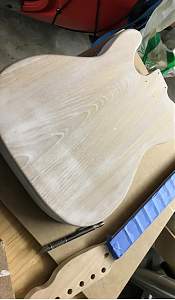Thanks for you comments.
I made a move forward over the last few days.
Side and rear grain filled with timbermate slurry and sanded back to 240 grit. There are 1 or 2 spots need additional fill and sand then I should be good to stain the rear.
After a practice run on scrap wood the headstock has been cut to a "fenderesque" shape using a coping saw followed by sanding to 400 grit including the entire neck (excluding the fret board). I am reasonably happy with the shape vs the template I downloaded.
On the loose bone nut PB will credit me for it - seems weird that the nuts they supply for a Fender build dont fit the nut slot







 Reply With Quote
Reply With Quote


